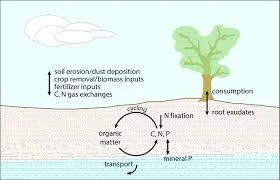Definition:Crop fertilizer recovery efficiency is a measure of how effectively applied nutrients are utilized by a crop to produce yield. It's a crucial indicator of fertilizer use efficiency and environmental impact.
Click the Translate button(see right) on this post to set your Own Language to understand more perfectly!!
Crop Fertilizer Recovery Efficiency Calculator
Definition Continue:
Crop Fertilizer Recovery Efficiency
Crop fertilizer recovery efficiency is a measure of how effectively applied nutrients are utilized by a crop to produce yield. It's a crucial indicator of fertilizer use efficiency and environmental impact.
Key Factors:
Applied Nutrients (kg): The total amount of a specific nutrient (e.g., nitrogen, phosphorus, potassium) applied to the field through fertilizer.
Nutrient Uptake (kg): The amount of the applied nutrient that is absorbed by the crop and incorporated into its biomass.
Crop Yield (kg): The total weight of the harvested crop.
Sample Values:
Applied Nutrients: 100 kg nitrogen per hectare
Nutrient Uptake: 30 kg nitrogen per hectare
Crop Yield: 5000 kg grain per hectare
Calculation Example:
Crop Fertilizer Recovery Efficiency (CFRE) = (Nutrient Uptake / Applied Nutrients) * 100
Using the sample values:
CFRE = (30 kg N / 100 kg N) * 100 = 30%
This means that 30% of the applied nitrogen was taken up by the crop, while the remaining 70% could have been lost through leaching, runoff, or other processes.
Additional Considerations:
Nutrient Form: Different fertilizer forms (e.g., organic, inorganic) have varying release rates and plant availability.
Soil Type: Soil properties influence nutrient retention and availability to plants.
Climate: Weather conditions affect nutrient loss through leaching and volatilization.
Crop Management: Practices like tillage, cover crops, and irrigation can impact nutrient uptake and loss.
Improving Fertilizer Recovery Efficiency:
Precision Agriculture: Applying fertilizers based on soil tests and crop needs can optimize nutrient use.
Nutrient Management Plans: Developing comprehensive plans to minimize nutrient losses and maximize crop uptake.
Soil Health: Improving soil structure and organic matter content enhances nutrient retention and availability.
Crop Rotation: Diversifying crops can help maintain soil fertility and reduce nutrient imbalances.
By understanding and improving crop fertilizer recovery efficiency, farmers can enhance crop productivity, reduce environmental impacts, and improve economic returns.
Let's delve deeper into crop fertilizer recovery efficiency
Crop Focus: Corn
Corn is a major global crop with a significant impact on food security. It's also a nutrient-demanding crop, particularly for nitrogen.
Nitrogen (N) utilization in corn: Corn is a heavy nitrogen feeder, requiring substantial amounts for optimal growth and yield. However, a significant portion of applied nitrogen can be lost through leaching, denitrification, or volatilization. Factors such as soil type, climate, and management practices influence nitrogen uptake efficiency.
Phosphorus (P) in corn production: While corn requires phosphorus, its efficiency in utilizing applied phosphorus is often lower than that of nitrogen. Soil phosphorus availability, pH, and organic matter content play crucial roles in phosphorus uptake.
Fertilizer Focus: Urea
Urea is a widely used nitrogen fertilizer due to its high nitrogen content.
Urea application and loss: Urea is prone to volatilization, especially under high-temperature and alkaline soil conditions. Proper application timing and methods can minimize these losses.
Urea inhibitors: These chemicals can be added to urea to reduce ammonia volatilization, improving nitrogen use efficiency.
Urea-based fertilizers: There are various urea-based formulations available, such as slow-release urea and urea-ammonium nitrate, which offer different release patterns and potential benefits for crop uptake.
Crop Focus: Wheat
Wheat is another staple crop with specific nutrient requirements.
Nitrogen management in wheat: Wheat responds well to nitrogen fertilization, but excessive application can lead to environmental issues. Split applications and considering soil nitrogen supply are crucial for optimizing nitrogen use.
Phosphorus and potassium in wheat: These nutrients are essential for wheat grain fill and quality. Soil testing can help determine the appropriate fertilizer rates.
Fertilizer Focus: Diammonium Phosphate (DAP)
DAP is a popular phosphorus and nitrogen fertilizer.
DAP composition: It provides a balanced ratio of nitrogen and phosphorus, making it suitable for crops with moderate requirements for both nutrients.
DAP placement: Proper placement of DAP is essential to prevent nutrient losses and maximize crop availability. Banding or deep placement can be effective methods.
Crop Focus: Rice
Rice is a water-loving crop with unique nutrient requirements.
Nitrogen management in rice: Rice is highly responsive to nitrogen, but excessive application can lead to environmental pollution and reduced grain quality. Controlled release nitrogen fertilizers can be beneficial.
Zinc deficiency in rice: Zinc is a micronutrient crucial for rice yield and quality. Zinc-fortified fertilizers can address zinc deficiency issues.
Fertilizer Focus: Potassium Chloride (Muriate of Potash)
Potassium is essential for rice growth and grain filling.
Potassium sources: Potassium chloride is a common potassium fertilizer, but its chloride content can be detrimental to some crops. Sulfate of potash is an alternative for chloride-sensitive crops.
Potassium application timing: Applying potassium at the appropriate growth stage is crucial for optimal utilization by the rice plant.
Crop Focus: Soybeans
Soybeans have a unique nitrogen fixation ability but still benefit from nitrogen fertilization.
Nitrogen fixation in soybeans: Symbiotic bacteria in soybean root nodules convert atmospheric nitrogen into a usable form for the plant. However, supplemental nitrogen can be beneficial under certain conditions.
Phosphorus and potassium for soybeans: These nutrients are essential for soybean yield and quality. Soil testing can help determine fertilizer needs.
Fertilizer Focus: Polyphosphates
Polyphosphates are slow-release phosphorus fertilizers that can improve phosphorus availability to plants.
Polyphosphate benefits: They can reduce phosphorus runoff and improve phosphorus use efficiency, especially in soils with high phosphorus fixation capacity.
Crop suitability: Polyphosphates can be beneficial for crops with high phosphorus requirements or grown on phosphorus-fixing soils.
Crop Focus: Oil Palm
Oil palm is an important oil crop with high nutrient demands.
Nutrient management in oil palm: Balanced fertilization is crucial for maintaining high yields and fruit quality. Macronutrients like nitrogen, phosphorus, and potassium, as well as micronutrients, are essential.
Fertilizer placement: Proper placement of fertilizers in oil palm plantations is important to avoid nutrient losses and optimize uptake.
Fertilizer Focus: Controlled-Release Fertilizers
Controlled-release fertilizers offer a sustained nutrient supply to crops.
Benefits of controlled-release fertilizers: They can reduce nutrient leaching, improve nutrient use efficiency, and provide a consistent nutrient supply to the crop.
Crop suitability: Controlled-release fertilizers can be beneficial for crops with specific nutrient requirements or in regions with high rainfall.
How is it possible to Earn Money using the knowledge of Crop Fertilizer Recovery Efficiency Calculation in our practical life?????
Monetizing Crop Fertilizer Recovery Efficiency Knowledge
Understanding and optimizing crop fertilizer recovery efficiency is crucial for sustainable agriculture. This knowledge can be monetized in several ways:
Consulting Services
Agricultural Consultant: Provide expert advice to farmers on improving fertilizer use efficiency. This includes conducting soil tests, developing fertilizer management plans, and monitoring crop nutrient uptake.
Precision Agriculture Consultant: Assist farmers in implementing precision agriculture technologies to optimize fertilizer applications based on variable soil conditions and crop needs.
Research and Development
Agronomist or Researcher: Work for agricultural research institutions or companies to develop new fertilizer products, application methods, or crop varieties with higher nutrient use efficiency.
Collaborate with Fertilizer Companies: Develop new fertilizer formulations or application technologies that improve nutrient uptake and reduce environmental impacts.
Education and Training
Agricultural Educator: Develop and deliver training programs for farmers, extension agents, and other stakeholders on fertilizer management and nutrient use efficiency.
Online Courses: Create online courses or webinars on topics like soil fertility, fertilizer application techniques, and crop nutrient management.
Software Development
Precision Agriculture Software Developer: Develop software applications that help farmers optimize fertilizer inputs based on various factors, including soil data, crop requirements, and weather conditions.
Government and Non-Profit Organizations
Policy Advisor: Work with government agencies to develop policies and regulations that promote sustainable fertilizer use and improve nutrient management practices.
Environmental Consultant: Assist organizations in assessing the environmental impacts of fertilizer use and developing mitigation strategies.
Additional Revenue Streams
Author or Speaker: Write books, articles, or give presentations on fertilizer management and nutrient use efficiency.
Expert Witness: Provide expert testimony in legal cases related to agricultural practices and environmental impacts.
By effectively communicating the importance of crop fertilizer recovery efficiency and providing practical solutions, professionals in this field can create significant value for farmers, the environment, and the agricultural industry as a whole.
Do YOU Want To Earn Money In Various Ways, Click The Link & Explore Your Field of Interest!!!








